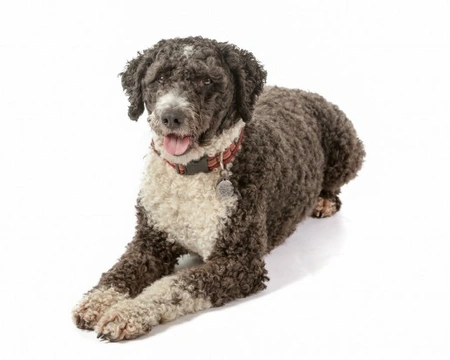
The Spanish water dog coat care and variants
The Spanish water dog is a medium sized dog with a curly coat, which originates on the Iberian coast in Spain, with a breed history going back to ancient times. As you might expect from the name, this breed is more than comfortable in the water, and is keen to swim given the chance! Within their home country, their working history is that of a gundog, and the breed as a whole is used to working closely with hunters to flush out game, retrieve prey and alert hunters to the presence of prey.
The Spanish water dog is still relatively uncommon within the UK, but they are growing in popularity year by year. There are only around 200 new Spanish water dogs registered with the UK Kennel Club each year, but as the breed is becoming increasingly more widely recognised and desired, their numbers are likely to increase! One of the traits that is responsible for making the Spanish water dog popular as a pet and better known outside of Spain is thanks to their coats, which are rather unusual and very unique. It is thought that the Poodle had some input into the genetic makeup of the Spanish water dog, and contributed somewhat towards the traits of the coat itself.
In this article, we will look in more detail at the coat type of the Spanish water dog, the different variants it can present in, and the type of care it needs. Read on to learn more!
The Spanish water dog coat type
The Spanish water dog’s coat is medium in length, and comprises of woolly cords, which are known as urls. The Poodle ancestry of the breed helped to establish the coat traits, and the coat of the Spanish water dog is very low shedding, and the coat forms itself into urls or dreadlocks that retain shed hair within the coat itself.
Despite the thickness and density of the urls of the coat, they are actually surprisingly well designed to keep themselves clean and tidy, and offer a superior level of protection to the underlying skin. The water dog’s urls repel mud and water, and do not tend to trap dirt and muck within them.
Despite their origins in the warmer climate of Spain, the coat itself is more than capable of offering adequate protection for the dog during the worst of the British weather, and will protect the dog from thorns and other sharp objects that they may brush against in the undergrowth.
Spanish water dog coat colours
The Spanish water dog’s coat comes in a very wide range of permitted colours within the breed standard, so there is lots of variety available! The permitted coat colours for the breed are:
- Brown
- Brown and tan
- Brown and white
- Brown with white markings
- Black
- Black and tan
- Black and white
- Black with white markings
- Cream
- Cream and white
- Cream with white markings
- Golden and white
- Golden with white markings
- Tricolour (three colours in combination)
- Plain white
- White and black
- White and brown
- White and cream
- White and golden
Caring for the coat of the Spanish water dog
The Spanish water dog is not considered to be one of the more challenging dogs to groom and maintain in terms of their coat, despite the unusual coat traits! While you might expect that the urls of the coat would require a significant amount of brushing and grooming, in reality, they should be left to grow naturally and not brushed or combed, which can damage the natural construction of the urls. If the coat picks up debris such as thorns, burrs or brambles, these should be removed by hand by teasing them out of the coat rather than brushing or picking them out with a comb.
The urls of the coat may grow into matts as they get progressively longer, so if this happens, simply teasing and pulling the coat apart into separate urls is the best way to keep the coat in good condition. The breed’s coat also offers them a layer of warmth and protection when they are in the water, and dogs of the breed do tend to be keen swimmers! The urls of the coat tend to repel water rather than absorb it, so when wet, they insulate the dog and do not weigh them down. Once they come out of the water, they will dry off very quickly by shaking off the droplets, and just a light towelling off is needed.
You can, if you wish, bath the Spanish water dog a couple of times a year if they begin to pong a bit, using a gentle, mild dog shampoo that is rinsed thoroughly and allowed to dry naturally. If you do find that your dog’s coat becomes prone to matted patches and tangling, you may consider clipping their coat; however, the coat is known to be relatively low maintenance, and part of the appeal of the breed.



